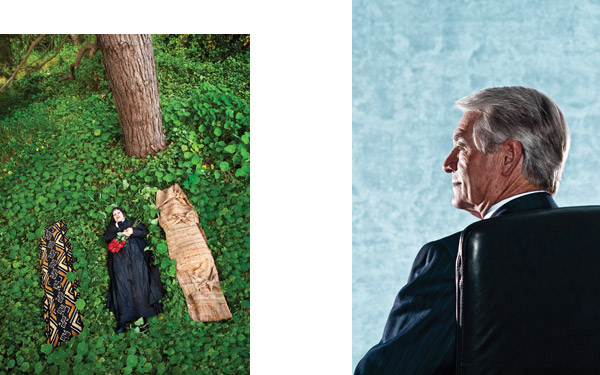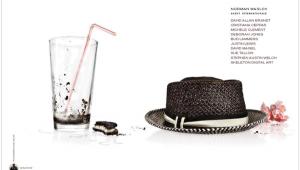The Business Of Editorial Photography: Telling Stories With Pictures, And Getting Paid To Do It


One of today’s best resources for learning about the business of editorial work is the national organization of Editorial Photographers, www.editorialphoto.com, and we are delighted to have three of the founding members on board for interviews: Robert Houser, www.bobhouser.com; Eric Millette, www.ericmillette.com; and Richard Morgenstein, www.morgenstein.com.
Also with us, with lots of editorial experience, are William Anthony, www.wmanthony.com and www.wmanthony.tumblr.com, and Alison Wright, www.alisonwright.com. But you don’t need 20 years experience to explore a career in editorial photography so we also talked with Robert Hooman, www.roberthooman.com, and Chris Goodney, www.chrisgoodney.com.


Shutterbug: How do you find your editorial clients?
Robert Hooman: My main goal is to get a one-on-one portfolio review with the editors and continue keeping in touch with them. So I’m really always approaching the client from a personal standpoint. I want to get to know them and create lasting bonds.
Chris Goodney: I started the old-fashioned way, finding the names of editors and art directors in the mastheads of magazines. At one point I had access to ADBASE and made good use of it as well. Other than that, word of mouth was my best seller. I met a good number of people in the two years I was assisting Arnold Newman so I just hit the pavement and started showing my book around. I started with one client and built on that. I think establishing a good relationship with your editor is a priceless thing. It really does come down to who you know and how good your work is, plain and simple.


William Anthony: This has markedly changed in just the past three years. In the past, it was not uncommon to get cold calls from editorial clients via inquiries from resources like ASMP’s “Find a Photographer.” This often seemed to be geographically motivated. If an East Coast publication was looking for a photographer in the Pacific Northwest, they would utilize these resources. In recent years, however, it really seems that referrals through social networking are taking precedence. Nowadays, building long-term relationships with art directors and photo editors may be the most successful and satisfying course.
Alison Wright: I took a risk by quitting my newspaper job in 1986 to follow my dream and take a three-week assignment shooting for UNICEF in Nepal. Once I arrived in the country I felt I’d come home and I didn’t leave for more than four years. UNICEF created a major project for me, photographing children’s issues around the country, and I made a living for years shooting for various aid and humanitarian organizations. I was earning a living and shooting what I felt was meaningful work—to help children and their communities. In fact, this work inspired my book Faces of Hope and a foundation of the same name, www.facesofhope.org.


Eric Millette: After photography school and then assisting for several years, I started shooting editorial photography back in 1991. Pounding the pavement in New York City was the tried and true path to getting work and I visited there often to meet face to face with photo editors. Eventually the client list grew and after about five years I felt like I was going to make it. Even though it seems like that is still a good method, it is harder to get those appointments and we have so many more options with the Internet.
Richard Morgenstein: I actually found it more and more difficult to find editorial clients. I used to look at magazines in bookstores to see what might be an appropriate fit, or at least a dream client. But I have found that it is just part of the research that is needed today. First of all, so many of the newsstand magazines are also seen by everyone else, and they often have the glamour factor that makes them magnets for photographers looking to promote. And with the consolidation in the magazine industry and dwindling budgets, these magazines tend to demand the most rights, often for the least amount of money.
I have used Agency Access to do research, and also made use of their mailing lists for both e-mail and hard copies of promotional materials. The magazines’ websites can often be a good indication of whether or not the client is going to have use for you and be able to pay you a reasonable amount for your work. You can tell who is using handouts, or hacks, and who actually appreciates good photography. This type of research can take some time, and may not be necessary for the inexpensive e-mail campaigns, but when sending out printed pieces it can really help to be targeted and not waste these pieces. Also, I look at strange or unfamiliar magazines whenever I can. Look for niches and nooks that are not getting marketed to as much as the big publications.


SB: What marketing techniques work best for finding editorial clients, given the different marketing tools available (advertising, direct mail, e-mail, websites, sales calls, and social media)?
Chris Goodney: In my experience I found that e-mail and websites are the tools most effective in this day and age. There are so many photographers out there now with the revolution of the digital age. I could throw a rock from my apartment window in Brooklyn and hit six photographers. So many clients won’t even speak to you until they check out your work first and see if you are a good fit for them. Having a strong website is the easiest way to get in the door and then “wow” them with your book.
Robert Hooman: There is an ocean of imagery and photographers now available to clients and the key is to reach and be reached by clients in a multitude of ways. While the traditional direct mailers and e-mail promos are necessary to compete in this new environment, other indirect methods seem to garner better results lately: networking, one-on-one portfolio reviews, search engine optimization, social media, and referrals by personal connections. Get on an editor’s radar and stay on their radar. Basically, think you’re a marketer first and a photographer second.
William Anthony: I am in the process of a complete website redo. My site was built with Flash but now needs to be cross-platform to be viewable on mobile devices and iPads. During this time I’ve opted for a Tumblr blog as it allows me to aggregate new followers. Tumblr’s social networking aspects make it good for content to go viral much quicker. It has limitations and shortfalls, which I hope to resolve when I launch the new site with an integrated blog, but for now it’s simple and dare I say, fun.
I use social networks not just to announce news but to give clients and followers an overall picture of who I am. That means the blog is not just new work announcements but things that inspire me, including links to videos, art, and stories that interest me. These are things that give someone a better picture of who I am and where my interests lie. This, in turn, also gives a prospective client a better idea of what it will be like to work with me. The other great part about social network marketing is it gives me a great opportunity to interact with people who are fans of the work (e.g., Twitter, Instagram, Facebook). It’s really more of a dialogue opposed to a broadcast now.
Eric Millette: I can never understand why a photographer uses Gmail, Yahoo!, etc. e-mail addresses instead of using their website domain’s e-mail address. That domain will show up in every piece of e-mail correspondence you do in and out of the industry. It’s a built-in calling card. I’ve had random people I’ve been corresponding with like insurance adjusters, auto mechanics, parents at my children’s school, etc. comment on my portfolio because they visited my website. You never know when one of those people is married to or has a family member in the industry.
Robert Houser: I approach marketing on many electronic fronts, such as my own custom website, numerous online portfolio sites, e-mail campaigns, blogging, social networks, tweeting, and lastly competitions. These days I think you need to do all of these approaches—coordinating your efforts as much as possible. While my environmental leanings have kept me from sending printed material for the past five to six years, I still make printed portfolios and I don’t think this should go away. Over my career the format of my printed books has changed, but I still like the idea of having a tangible example of my work. Whenever possible, I try to get to see people face to face because, like anything, this business is about relationships. They can be forged and supported electronically, but the face-to-face meeting still carries a lot of weight.



SB: What is the biggest industry change you have seen in the editorial photography business in the last five years?
Richard Morgenstein: Bad contracts granting publishers more and more rights while passing on as much liability as possible to the photographer for the publishers’ possible screw-ups.
Seriously…read those contracts. That and lower budgets (if that is possible). Ludicrously low. If you have enough jobs per week, you can make enough money to live on in the editorial world, but it is harder and harder these days. There are too many photographers who don’t really run businesses, but instead are subsidizing publishers one way or another.
Alison Wright: The digital age has completely changed my workflow. I have 35 filing cabinets of slides crammed into my office. Now I have 20 terabytes of hard drives sitting on my desk. It’s a daily chore just keeping up with the technological taming of all this. I could scan, metadata, and tweak photos until the day I die and still not be caught up.
Robert Houser: In the next few years the editorial market will face some big changes with the rollout of digital editions for iPads and other portable devices. I don’t think we’ve yet seen anyone handling this format in the final version yet. Like any new technology, the initial attempts don’t have the artistic polish that will come over time—there’s more of an emphasis to just get some image up there. I’m confident that publishers will see the need for quality editorial content as the newer platforms for their publications stabilize. I think consumers will be willing to pay for this content, and will expect good-looking quality. The acceptance of low-res YouTube videos and Flickr images will wane as the technology becomes commonplace.
SB: What is the most important thing you have found that keeps editorial clients coming back for repeat business with you?
Alison Wright: A personal relationship. It’s all in the timing. I’m tenacious about keeping in touch, even when a magazine hasn’t given me work in a while. For instance, I’d always gone to see the editors at Smithsonian Magazine and it wasn’t until the Haiti earthquake hit that I got a call from them saying, “We finally have the perfect assignment for you.”
I travel continuously and I also let editors know where I’m going. I’ve shot four books for National Geographic in the last year: Great Britain, London, and most recently I was just in China for a few months and I spread the word where I’d be. Islands magazine contacted me to shoot a surfing story on Hainan Island for them while I was over there. I was thrilled to have any excuse to escape the last brutal New York winter. I always try to piggyback more than one assignment when I travel.
Robert Houser: Professionalism—doing solid work, on time, delivered well. These latter points I think cannot be stressed enough. When dealing with a busy editor, the more you can make their life easier with frequent communication (when the shoot is scheduled, how it went, and when they can expect the images), and on-time delivery without surprises (as in no budget changes or image problems), the more they are apt to hire you again.
In addition to the reputation you will gain for your images, you also want the editors to remember you as someone easy to work with—as editorial budgets have shifted, they are working more and faster, and they don’t have extra time to deal with someone difficult. For editorial portrait projects, I like it when I can say to the editor, give me the subject’s contact information and the deadline date and I’ll take it from there. They don’t have to deal with the scheduling, travel arrangements, PR people—they just get an e-mail back in a day or so saying when it’s booked and when they will see images. And, if I say Wednesday, they will see images on Wednesday—100 percent, even if I have to stay up all night because of a conflict on my end.


SB: What recommendation would you make to a photographer looking to make a career move into this field?
Eric Millette: Get your head examined! Seriously, you need to have a miniscule overhead and own as little equipment as you can get by with. Be a Photoshop wiz and an innovative idea mill. Assist other photographers so you don’t make mistakes that can cost you clients.
Robert Houser: Shoot a lot, blog a lot, Facebook and Twitter those images a lot, but don’t make all that sound like blatant sales pitches. Do personal projects you believe in and blog about those with the enthusiasm you have for shooting them. That sincerity will come through. And, never feel you are not ready to show your book—make the calls, drop it off, go see people. It’s all practice and it will pay off—if not right away, eventually.
Richard Morgenstein: Make sure you are shooting what you love, and show it proudly. Push stuff to extremes (photographically). Tell stories about making the images that are memorable and amusing but positive! Showcase your skills whenever you can. Learn to be a bit of a shameless self-promoter (if it does not come naturally to you). Learn to communicate about your vision in some semi-coherent manner. Editorial is where much of the cutting-edge work is done, especially in high-profile magazines, so you really need to try new things all the time, and attempt to find and understand your “brand” and vision. Shoot personal work all the time.
Alison Wright: Take a business class, seriously. With so many people being able to make photos, the key is to know how to market your product. If you’re going to do editorial work be prepared to support yourself through teaching workshops, classes, photo tours, funding, and commercial work. I know very few photographers who make a living shooting only pure editorial assignments anymore. And always shoot your own personal projects. It’s what you’re most passionate about and where your work will shine. It’s why most of us choose this path anyway, not to get rich, but because we care and have something to say.















































